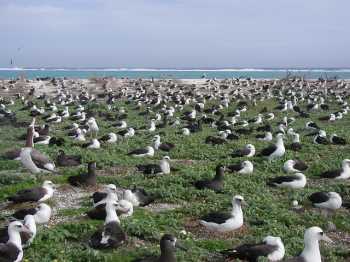This year's Japanese tsunami killed many tens of thousands of Black-browed Phoebastria nigripes and Laysan P. immutabilis Albatross chicks on the low-lying islands of the North Pacific (click here). However, a more insidious threat from the tsunami still exists from the debris it washed into the North Pacific Ocean.
The University of Hawai‘i at Mānoa's International Pacific Research Center (IPRC) has been modelling the likely route of this massive pulse of debris (click here). Its findings were sent to the Russian sail training ship Pallada, which crossed from Hawaii to Vladivostok late last month, when it discovered an extended field of tsunami-caused debris over a period of several days after passing by Midway Atoll.
"We keep sighting everyday things like wooden boards, plastic bottles, buoys from fishing nets (small and big ones), an object resembling wash basin, drums, boots, other wastes. The ship came across a Japanese fishing boat bearing inscriptions it came from Japan's Fukushima Prefecture, which suffered severe damage from the tsunami. The boat was brought on board the Pallada. The debris was within the debris field predicted by the computer models". Fortunately, tests for radiation from the damaged Japanese nuclear plant did not reveal raised levels (click here for a report on possible radiation in shearwaters).
The IPRC researchers believe the debris may hit Midway Atoll and other parts of the Northwestern Hawaiian Islands this [northern] winter, and could reach the main Hawaiian Islands later and eventually the North American West Coast. Click here for more information and pictures.
Meanwhile on Kure Atoll a team has been working at removing washed-up tsunami marine debris from the albatross breeding colony: "There was a large strand line of mooring balls, bottles, buckets, and fishing debris in the back of the nesting area. The objects can blow around during storms and kill chicks and native plants. We are also removing tree branches and some non-native trees (heliotropes) out of the east colony. Tree branches snag flying albatross out of the sky. Some birds hang in the trees for days before they die. Branches on the ground are obstacles for albatross to walk around and landing in a pile of branches can be fatal if the bird breaks a leg or wing."

A mixed colony of Black-footed and Laysan Albatrosses
With thanks to Cynthia Vanderlip and Lindsay Young for information.
John Cooper, ACAP Information Officer, 20 October 2011

 English
English  Français
Français  Español
Español